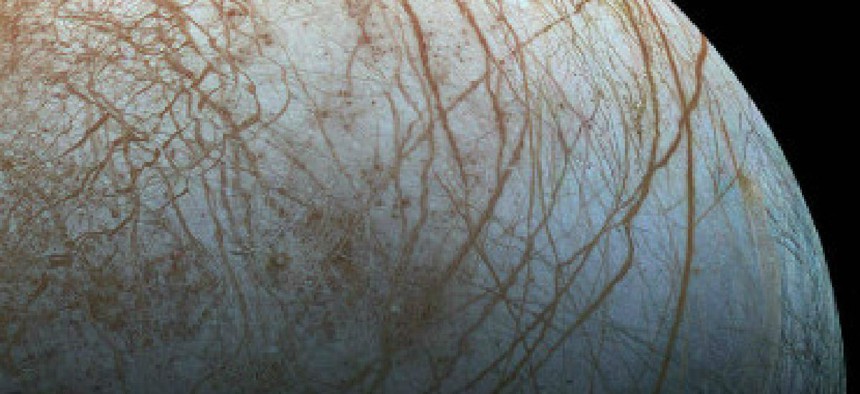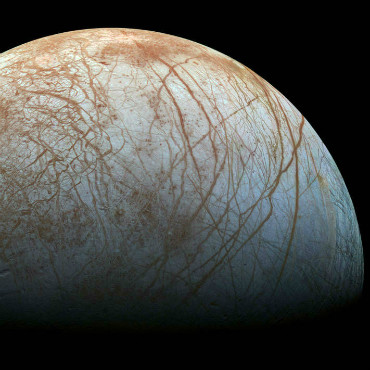NASA picks 9 tools to scope out icy moon – and maybe alien life

Europa, frozen moon of Jupiter, might hold vast oceans and even life. NASA has OK'd a fleet of instruments aimed at exposing her secrets.
The space agency recently announced the selection of that will be used to analyze Europa, the icy moon of Jupiter that may be home to subglacial oceans and, possibly, life.
“This is a giant step in our search for oases that could support life in our own celestial backyard,” Curt Niebur, scientist at NASA Headquarters in Washington, said in announcing the program. “We’re confident that this versatile set of science instruments will produce exciting discoveries on a much-anticipated mission.”
After soliciting proposals for Europa instruments last year, NASA reviewed 33 possibilities and selected nine instruments, from ice-penetrating radar to thermal imaging systems.
The aim: Get intimate with a moon that could hold twice as much water as the Earth -- and be home to life.
“Europa has tantalized us with its enigmatic icy surface and evidence of a vast ocean, following the amazing data from 11 flybys of the Galileo spacecraft over a decade ago and recent Hubble observations suggesting plumes of water shooting out from the moon," said John Grunsfeld, associate administrator for NASA’s Science Mission Directorate. “We’re excited about the potential of this new mission and these instruments to unravel the mysteries of Europa in our quest to find evidence of life beyond Earth.”
The instruments are not off-the-shelf solutions.
“A lot of people mistakenly believe that we simply use standard instruments on our missions. We don’t,” Niebur told FCW. “Each instrument is a unique piece specially designed to do its unique job in a unique environment.”
The nine below, per NASA’s announcement:
The instruments won’t be scoping out Europa for years.
“It’s important to keep in mind that the [investigators] did not submit proposals with the final blueprints for their instruments,” Niebur told FCW. “They provided a ‘first draft’ of a design for their instruments … [b]ut now the rubber meets the road. They need to prove the design will work, and to improve it as needed.”
Niebur noted that investigators will face the “big challenge” of designing instruments that work together and with the entire spacecraft.
Over the next two years, spacecraft and instrument design will be iteratively tweaked in an “incredibly complex and detailed” process to ensure everything fits together, Niebur said.
Actually building hardware will take another three years, and that will be followed by roughly a year and a half of assembly and testing.
“Of course, the pace at which we work is dependent upon how much funding we receive,” Niebur said. “But even with all the money in the world you can only physically fit so many people around the spacecraft at a time to work on it.”
The selection of scientific instruments is a huge step forward, Niebur said, but the design of the spacecraft’s power, propulsion and other systems will be tough.
“Imagine your car having to survive temperature fluctuations of hundreds of degrees, radiation levels like those inside a nuclear reactor, rocks being thrown at it, huge vibrations, etc.,” Niebur said. “And no maintenance or checkups ever.”
And despite the progress, the fact that much remains to be done may be best demonstrated by NASA’s statement on the tool that would actually get the other tools off the launch pad: “[I]t is premature to discuss a rocket for a Europa mission at this time.”
The Europa mission has $30 million set aside in the president’s fiscal 2016 , a figure slated to ramp up to $100 million by 2020.


Europa could hold twice as much water as the Earth -- and be home to life. (Image: NASA)
NASA is trekking toward the answer to one of science’s most intriguing questions: Are humans truly alone in our solar system?
nine instruments
The tools to chart the moon
Europa program
- Plasma Instrument for Magnetic Sounding (PIMS) -- principal investigator Joseph Westlake of Johns Hopkins Applied Physics Laboratory, Laurel, Md. This instrument works in conjunction with a magnetometer and is key to determining Europa's ice shell thickness, ocean depth and salinity by correcting the magnetic induction signal for plasma currents around Europa.
- Interior Characterization of Europa using Magnetometry (ICEMAG) -- principal investigator Carol Raymond of NASA’s Jet Propulsion Laboratory, Pasadena, Calif. This magnetometer will measure the magnetic field near Europa and -- in conjunction with the PIMS instrument -- infer the location, thickness and salinity of Europa’s subsurface ocean using multi-frequency electromagnetic sounding.
- Mapping Imaging Spectrometer for Europa (MISE) -- principal investigator Diana Blaney of JPL. This instrument will probe the composition of Europa, identifying and mapping the distributions of organics, salts, acid hydrates, water ice phases and other materials to determine the habitability of Europa’s ocean.
- Europa Imaging System (EIS) -- principal investigator Elizabeth Turtle of APL. The wide and narrow angle cameras on this instrument will map most of Europa at 50 meter (164 foot) resolution, and will provide images of areas of Europa’s surface at up to 100 times higher resolution.
- Radar for Europa Assessment and Sounding: Ocean to Near-surface (REASON) -- principal investigator Donald Blankenship of the University of Texas, Austin. This dual-frequency ice penetrating radar instrument is designed to characterize and sound Europa's icy crust from the near-surface to the ocean, revealing the hidden structure of Europa’s ice shell and potential water within.
- Europa Thermal Emission Imaging System (E-THEMIS) -- principal investigator Philip Christensen of Arizona State University, Tempe. This “heat detector” will provide high spatial resolution, multi-spectral thermal imaging of Europa to help detect active sites, such as potential vents erupting plumes of water into space.
- MAss SPectrometer for Planetary EXploration/Europa (MASPEX) -- principal investigator Jack (Hunter) Waite of the Southwest Research Institute (SwRI), San Antonio, Texas. This instrument will determine the composition of the surface and subsurface ocean by measuring Europa’s extremely tenuous atmosphere and any surface material ejected into space.
- Ultraviolet Spectrograph/Europa (UVS) -- principal investigator Kurt Retherford of SwRI. This instrument will adopt the same technique used by the Hubble Space Telescope to detect the likely presence of water plumes erupting from Europa’s surface. UVS will be able to detect small plumes and will provide valuable data about the composition and dynamics of the moon’s rarefied atmosphere.
- SUrface Dust Mass Analyzer (SUDA) -- principal investigator Sascha Kempf of the University of Colorado, Boulder. This instrument will measure the composition of small, solid particles ejected from Europa, providing the opportunity to directly sample the surface and potential plumes on low-altitude flybys.
budget request


